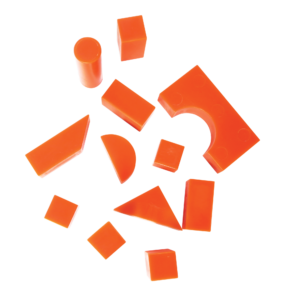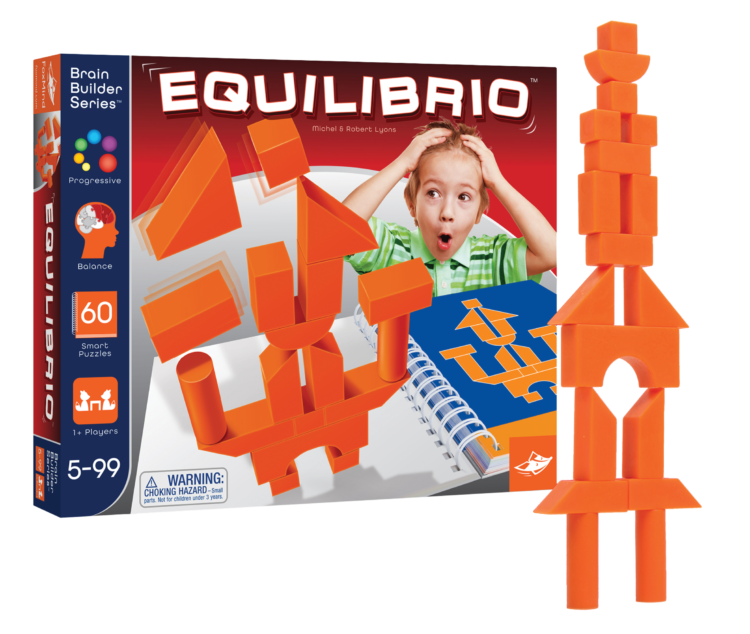Equilibrio is part of the Architecto line by FoxMind Games, a series of puzzle games that focus on spatial visualization by building structures out of blocks. The game provides players with a rule book that includes sixty puzzles that gradually progress in difficulty. This allows for differentiation for students to play at the level they are comfortable at. The rule book also provides students with a clue section for beginner players.
 Equilibrio is comprised of eighteen solid plastic building blocks, referred as “Geoblocks”. The Geoblocks are various geometric shapes, and are represented in a variety of transitions in the puzzle book. The object of Equilibrio, is to successfully and accurately build the structure illustrated in the puzzle. Each illustration should be constructed vertically and when finished, should maintain equilibrium. One wrong move, and the whole tower could come crashing down! This game is meant for one player, but can easily be
Equilibrio is comprised of eighteen solid plastic building blocks, referred as “Geoblocks”. The Geoblocks are various geometric shapes, and are represented in a variety of transitions in the puzzle book. The object of Equilibrio, is to successfully and accurately build the structure illustrated in the puzzle. Each illustration should be constructed vertically and when finished, should maintain equilibrium. One wrong move, and the whole tower could come crashing down! This game is meant for one player, but can easily be  modified for students to work in pairs. The extensions for game play are unlimited. It is amazing how this non-competitive game can be intrinsically motivating for students, allowing students to act as agents in their own growth decreasing the need for external rewards. This game provides an amplitude of opportunities for students to use dexterity, ingenuity, and spatial visualization. It is deeply encouraged that each player uses their imagination!
modified for students to work in pairs. The extensions for game play are unlimited. It is amazing how this non-competitive game can be intrinsically motivating for students, allowing students to act as agents in their own growth decreasing the need for external rewards. This game provides an amplitude of opportunities for students to use dexterity, ingenuity, and spatial visualization. It is deeply encouraged that each player uses their imagination!
Click on this link for student resources: Equilibrio Student Record Sheets
Click on this link for teacher resources: Equilibrio Teacher Resource Sheets
Curriculum Connections
Coming soon.
Connections to Processes
Communication [C] : When students first play Equilibrio, a variety of rich communication takes place. When discovering and interacting with the geoblock manipulatives for the first time, there is ample opportunity for students to discuss mathematical thinking. Equilibrio provides opportunities for students to communicate in mathematical terms, thereby fostering interaction and exploration of ideas related to course curriculum. Then while building the puzzles, students can communicate directions to one another, based on their mathematical ideas. As students advance through the puzzles the teacher can use prompts to start introducing correct mathematical language such as symmetry, geometric attributes, transitions, and more.
When providing extensions to Equilibrio, there are sufficient opportunities to engage students in communication. For example, if the students work in pairs, they can play a game where one student must verbally describe the puzzle while their partner builds it. This teaches the students to be articulate in their explainations and provides a deeper understanding of geometric shapes.
Connections [CN] : Equilibrio allows for students to make in-depth connections to building towers, geoblocks, and puzzles. The language they use to analyze and describe the blocks and towers can be a gateway to correct terminology. This creates a more in-depth understanding when students make connections between previous knowledge and the new materials of Equilibrio.
Extending Equilibrio to get students to create their own tower design, allows them to make geometric connections between their drawn puzzle and their concrete tower design. Students will learn to communicate the attributes of the two dimensional drawing to create the three dimensional geoblocks.
Mental Mathematics and Estimation [ME] : When students are playing Equilibrio they must consider what pieces may be hidden. In the challenging structures, pieces can rotate by 45 degrees so students must visuatlize to estimate how that piece may be placed.
Problem Solving [PS] : Equilibrio provides students with sixty puzzles, gradually increasing in difficulty. As the puzzles increase in difficulty, the more strategies and reasoning the player must use to be successful at building the tower. The student must analyze the two dimensional representations and apply them to create the three dimensional geoblocks. In order to succeed, the student must use effective and efficient problem solving strategies. The students must take risks while playing Equilibrium, leading to creative and innovative solutions. Since this game is meant for one player, it is fantastic at motivating students intrinsically to solve problems. This may lead to the students taking risks, realizing there are multiple methods/solutions and developing mathematical confidence. Equilibrio extension activities also provide rich tasks related to problem solving. For example, asking students to switch puzzle designs with someone, may lead to collaboration and discussion of different problem solving methods.
Reasoning [R] : Equilibrium helps students build a strong foundation in geometric reasoning. When students are playing Equilibrio in pairs, they will need to communicate their reasoning for different strategies and work together to complete the task. Through game play, students are able to generalize patterns of previously tested strategies, and reach new conclusions from their background knowledge.
Technology [T] : Although you are unable to play equilibrio on a device, depending on the extension activities used with Equilibrio, technology can play a vital role in developing the other mathematical processes. It will also provide an outlet for students to better communicate, rather than the traditional pencil to paper style. For example, using an app where students can take a picture of their tower, then present it by recording their voice while drawing directly on the screen can provide teachers with a great amount of data to understand your students’ thinking.
Visualization [V] : Equilibrio provides rich tasks for students to interpret and describe a visual representation by developing their spatial sense (the ability to mentally visualize objects and spatial relationships) and reasoning. As the students look at the puzzle book and 2D representations of the shape, they must make connections with the geoblocks, 3D objects, and use their connections to build the tower correctly. This enables a great opportunity for students to form relationships among the 2D shapes and 3D objects. With the use of extensions, students are also able to actively interpret and describe visual representations of their tower and it’s composed shapes through spatial reasoning.
